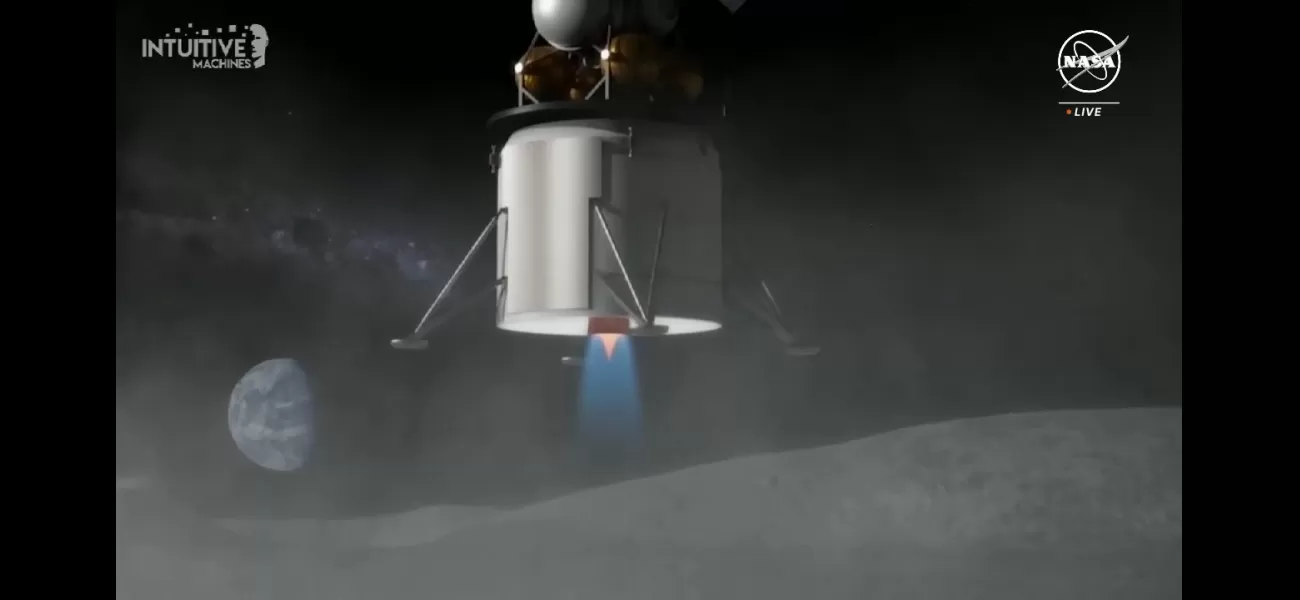The moon has been reached by the commercial spacecraft Odysseus for the first time.
The Odysseus lunar lander marks the first US spacecraft to reach the moon in 50+ years.
February 22nd 2024.

On Thursday, the Odysseus lunar lander, developed by Intuitive Machines, made a historic touchdown on the moon. It became the first private probe to successfully land on the lunar surface, marking a significant milestone for space exploration. The lander, affectionately nicknamed "Odie" or "IM-1", also holds the title of being the first US-made spacecraft to land on the moon in over 50 years.
The journey was not without its challenges, as Odysseus encountered some navigation issues before making a soft landing near the Malapert A crater, approximately 186 miles from the moon's south pole. However, despite the nail-biting moments, the team at Intuitive Machines was able to successfully guide the lander to its destination. "I know this was a tense moment, but we did it. We are now on the surface of the moon and we are transmitting," said Stephen Altemus, the president and CEO of Intuitive Machines. "Welcome to the moon!"
The excitement was not limited to the team at Intuitive Machines, as members of the Scorpius Space Launch Company in Torrance, California also cheered and celebrated as Odie touched down on the moon. The lander did experience some communication challenges, but after about 10 minutes, it was able to complete its landing. "Houston, Odysseus has found its new home," Altemus announced proudly.
The condition of the lander was not immediately known, as engineers at Intuitive Machines' Nova control center did not immediately receive a signal from Odie. However, a faint signal finally came through a communications antenna in the UK, confirming the successful touchdown. "What we can confirm, without a doubt, is that our equipment is on the surface of the moon and we are transmitting," said mission director Tim Crain to the flight control team. "So congratulations, IM team! Let's see what else we can learn from this."
Unfortunately, images of Odysseus after its landing were not immediately available. The lander had departed from Earth just a week prior, aboard a SpaceX rocket, and entered the moon's orbit on Wednesday. In order to compensate for its own laser instrument failing, Odie made an extra lunar orbit and utilized NASA's Navigation Doppler Lidar. Its mission is to collect vital information about the moon's south pole, in preparation for a planned crewed mission in 2026.
Odysseus' success comes just a month after the American Peregrine spacecraft's failed attempt at a lunar landing, when it caught fire in the atmosphere and fell back to Earth. The fact that Odie was able to complete its mission without any major setbacks is a testament to the hard work and dedication of the team at Intuitive Machines. "We are thrilled to have achieved this groundbreaking feat and we look forward to discovering even more about the moon's south pole," said Altemus, with a sense of pride and accomplishment.
The journey was not without its challenges, as Odysseus encountered some navigation issues before making a soft landing near the Malapert A crater, approximately 186 miles from the moon's south pole. However, despite the nail-biting moments, the team at Intuitive Machines was able to successfully guide the lander to its destination. "I know this was a tense moment, but we did it. We are now on the surface of the moon and we are transmitting," said Stephen Altemus, the president and CEO of Intuitive Machines. "Welcome to the moon!"
The excitement was not limited to the team at Intuitive Machines, as members of the Scorpius Space Launch Company in Torrance, California also cheered and celebrated as Odie touched down on the moon. The lander did experience some communication challenges, but after about 10 minutes, it was able to complete its landing. "Houston, Odysseus has found its new home," Altemus announced proudly.
The condition of the lander was not immediately known, as engineers at Intuitive Machines' Nova control center did not immediately receive a signal from Odie. However, a faint signal finally came through a communications antenna in the UK, confirming the successful touchdown. "What we can confirm, without a doubt, is that our equipment is on the surface of the moon and we are transmitting," said mission director Tim Crain to the flight control team. "So congratulations, IM team! Let's see what else we can learn from this."
Unfortunately, images of Odysseus after its landing were not immediately available. The lander had departed from Earth just a week prior, aboard a SpaceX rocket, and entered the moon's orbit on Wednesday. In order to compensate for its own laser instrument failing, Odie made an extra lunar orbit and utilized NASA's Navigation Doppler Lidar. Its mission is to collect vital information about the moon's south pole, in preparation for a planned crewed mission in 2026.
Odysseus' success comes just a month after the American Peregrine spacecraft's failed attempt at a lunar landing, when it caught fire in the atmosphere and fell back to Earth. The fact that Odie was able to complete its mission without any major setbacks is a testament to the hard work and dedication of the team at Intuitive Machines. "We are thrilled to have achieved this groundbreaking feat and we look forward to discovering even more about the moon's south pole," said Altemus, with a sense of pride and accomplishment.
[This article has been trending online recently and has been generated with AI. Your feed is customized.]
[Generative AI is experimental.]
0
0
Submit Comment





